Performance Evaluation of Biomimetic-Designed Rotary Blades for Straw Incorporation in an Intensive Tillage System
Abstract
:1. Introduction
2. Materials and Methods
2.1. Description of the Test Site
2.2. Designs of Rotary Blades
2.3. Description of the In Situ Test Rig
2.4. Experimental Design
2.5. Measurement
2.5.1. Straw Displacement
2.5.2. Straw Burying Rate
2.5.3. Straw Distribution
2.5.4. Torque and Power
2.6. Data Analysis
3. Results and Discussion
3.1. Straw Displacement
3.2. Straw Burying Rate
3.3. Straw Distribution
3.4. Torque and Power
3.5. Discussion
3.5.1. Theory of Biomimetic Designed Toothed Blades as Straw Incorporation Tool
3.5.2. Effect of Biomimetic-Designed Blades on the Performance of Straw Incorporation by Rotary Tillage
4. Conclusions
Author Contributions
Funding
Institutional Review Board Statement
Informed Consent Statement
Data Availability Statement
Conflicts of Interest
References
- Ittersum, V.; Martin, K. Crop yields and global food security. Will yield increase continue to feed the world? Eur. Rev. Agric. Econ. 2016, 97, 191–192. [Google Scholar] [CrossRef]
- Xu, G.; Xie, Y.; Matin, M.A.; He, R.; Ding, Q. Effect of straw length, stubble height and rotary speed on residue incorporation by rotary tillage in intensive rice–wheat rotation system. Agriculture 2022, 12, 222. [Google Scholar] [CrossRef]
- Liang, Z.; Wada, M.E. Development of cleaning systems for combine harvesters: A review. Biosyst. Eng. 2023, 236, 79–102. [Google Scholar] [CrossRef]
- Zhou, M.; Wei, Z.; Wang, Z.; Sun, H.; Wang, G.; Yin, J. Design and experimental investigation of a transplanting mechanism for super rice pot seedlings. Agriculture 2023, 13, 1920. [Google Scholar] [CrossRef]
- Ding, C.; Wang, L.; Chen, X.; Yang, H.; Huang, L.; Song, X. A blockchain-base wide-area agricultural machinery resource scheduling system. Appl. Eng. Agric. 2023, 39, 15332. [Google Scholar] [CrossRef]
- Zeng, Z.; Chen, Y. Performance evaluation of fluted coulters and rippled discs for vertical tillage. Soil. Till. Res. 2018, 183, 93–99. [Google Scholar] [CrossRef]
- Torotwa, I.; Ding, Q.; Makange, N.R.; Liang, L.; He, R. Performance evaluation of a biomimetically designed disc for dense-straw mulched conservation tillage. Soil. Till. Res. 2021, 212, 105068–105077. [Google Scholar] [CrossRef]
- Eltom, A.F.; Ding, W.; Tagar, A.A.; Talha, Z.; Gamareldawla. Field investigation of a trash-board, tillage depth and low speed effect on the displacement and burial of straw. Catena 2015, 133, 385–393. [Google Scholar] [CrossRef]
- Zhou, H.; Zhang, C.; Zhang, W.; Yang, Q.; Li, D.; Liu, Z.; Xia, J. Evaluation of straw spatial distribution after straw incorporation into soil for different tillage tools. Soil. Till. Res. 2020, 196, 104440. [Google Scholar] [CrossRef]
- Fang, H.; Zhang, Q.; Chandio, F.A.; Guo, J.; Sattar, A.; Arslan, C.; Ji, C. Effect of straw length and rotavator kinematic parameter on soil and straw movement by a rotary blade. Eng. Agric. Environ. Food 2016, 9, 235–241. [Google Scholar] [CrossRef]
- Shi, Y.; Xin, S.; Wang, X.; Hu, Z.; Newman, D.; Ding, W. Numerical simulation and field tests of minimum-tillage planter with straw smashing and strip laying based on EDEM software. Comput. Electron. Agric. 2019, 166, 105021. [Google Scholar] [CrossRef]
- Xu, G.; Xie, Y.; Liang, L.; Alete, J.O.; Chen, X.; Abbas, A.; Matin, M.A.; He, R.; Ding, Q. A novel method for measuring and evaluating spatial distribution of straw incorporated by rotary tillage. Agron. J. 2022, 114, 853–866. [Google Scholar] [CrossRef]
- Fang, H.; Niu, M.; Zhu, Z.; Zhang, Q. Experimental and numerical investigations of the impacts of separating board and anti-blocking mechanism on maize seeding. J. Agric. Eng. 2022, 53, 1–10. [Google Scholar]
- Ahmad, F.; Qiu, B.; Ding, Q.; Ding, W.; Khan, Z.M.; Shoaib, M.; Chandio, F.A.; Rehim, A.; Khaliq, A. Discrete element method simulation of disc type furrow openers in paddy soil. Int. J. Agric. Biol. Eng. 2020, 13, 103–109. [Google Scholar] [CrossRef]
- Jia, H.; Wang, W.; Wang, W.; Zheng, J.; Wang, Q.; Zhang, J. Application of anti-adhesion structure based on earthworm motion characteristics. Soil. Till. Res. 2018, 162, 34–40. [Google Scholar] [CrossRef]
- Ren, L.Q.; Tong, J.; Li, J.Q.; Chen, B.C. Soil adhesion and biomimetics of soil-engaging components: A review. J. Agric. Eng. Res. 2001, 79, 239–263. [Google Scholar] [CrossRef]
- Chirende, B.; Li, J. Review on application of biomimetics in the design of agricultural implements. Biotechnol. Mol. Biol. Rev. 2009, 4, 42–48. [Google Scholar]
- Hu, J.; Xu, L.; Yu, Y.; Lu, J.; Han, D.; Chai, X.; Wu, Q.; Zhu, L. Design and experiment of bionic straw-cutting blades based on locusta migratoria manilensis. Agriculture 2023, 13, 2231. [Google Scholar] [CrossRef]
- Tong, J.; Moayad, B.Z.; Ma, Y.; Sun, J.; Chen, D.; Jia, H. Effects of biomimetic surface designs on furrow opener performance. J. Bionic Eng. 2009, 6, 280–289. [Google Scholar] [CrossRef]
- Ji, W.; Chen, D.; Jia, H.; Tong, J. Experimental investigation into soil-cutting performance of the claws of mole rat (Scaptochirus moschatus). J. Bionic Eng. 2010, 7, 166–171. [Google Scholar] [CrossRef]
- Jia, H.; Wang, Q.; Huang, D.; Zhu, L.; Li, M.; Zhao, J. Design of bionic mole forelimb intelligent row cleaners. Int. J. Agric. Biol. Eng. 2019, 12, 27–35. [Google Scholar] [CrossRef]
- Guan, C.; Fu, J.; Xu, L.; Jiang, X.; Wang, S.; Cui, Z. Study on the reduction of soil adhesion and tillage force of bionic cutter teeth in secondary soil crushing. Biosyst. Eng. 2020, 213, 133–147. [Google Scholar] [CrossRef]
- Song, W.; Jiang, X.; Li, L.; Ren, L.; Tong, J. Increasing the width of disturbance of plough pan with bionic inspired subsoilers. Soil. Till. Res. 2022, 220, 105356. [Google Scholar] [CrossRef]
- Sun, J.; Chen, H.; Wang, Z.; Ou, Z.; Yang, Z.; Liu, Z.; Duan, J. Study on plowing performance of EDEM low-resistance animal bionic device based on red soil. Soil. Till. Res. 2020, 196, 104336. [Google Scholar] [CrossRef]
- Yang, Y.; Li, M.; Tong, J.; Ma, Y. Study on the interaction between soil and the five-claw combination of a mole using the discrete element method. Appl. Bionics Biomech. 2018, 2018, 7854052. [Google Scholar] [CrossRef]
- Xu, G.; Xie, Y.; Liang, L.; Ding, Q.; Xie, H.; Wang, J. Straw-soil-rotary blade interaction: Interactive effects of multiple operation parameters on the straw movement. Agronomy 2022, 112, 847. [Google Scholar] [CrossRef]
- Tong, J.; Ji, W.; Jia, H.; Chen, D.; Yang, X. Design and tests of biomimetic blades for soil-rototilling and stubble-breaking. J. Bionic Eng. 2015, 12, 495–503. [Google Scholar] [CrossRef]
- Guo, J.; Ji, C.; Fang, H.; Zhang, Q.; Hua, F.; Zhang, C. Experimental analysis of soil and Straw displacement after up-cut and down-cut rotary tillage. Trans. Chin. Soc. Agric. Eng. 2016, 47, 21–26. (In Chinese) [Google Scholar]
- Eagle, A.J.; Bird, J.A.; Hill, J.E.; Horwath, W.R.; van Kessel, C. Rice: Nitrogen dynamics and fertilizer use efficiency in rice following straw incorporation and winter flooding. Agron. J. 2001, 93, 1346–1354. [Google Scholar] [CrossRef]
- Guan, X.; Wei, L.; Turner, N.; Ma, S.; Yang, M.; Wang, T. Improved straw management practices promote in situ straw decomposition and nutrient release, and increase crop production. J. Clean. Prod. 2020, 250, 119514.1–119514.13. [Google Scholar]
- Chen, Q.; Shi, Y.; Ding, Q.; Ding, W.; Tian, Y. Comparison of straw incorporation effect with down-cut and up-cut rotary tillage. Trans. Chin. Soc. Agric. Eng. 2015, 31, 13–18. (In Chinese) [Google Scholar]
- Zeng, Z.; Chen, Y. Simulation of straw movement by discrete element modelling of straw-sweep-soil interaction. Biosyst. Eng. 2019, 180, 25–35. [Google Scholar] [CrossRef]
- Zeng, Z.; Ma, X.; Chen, Y.; Qi, L. Modelling residue incorporation of selected chisel ploughing tools using the discrete element method (DEM). Soil. Till. Res. 2020, 197, 104505. [Google Scholar] [CrossRef]
- Ji, W.; Jia, H.; Tong, J. Experiment on working performance of bionic blade for soil-rototilling and stubble-breaking. Trans. Chin. Soc. Agric. Eng. 2012, 28, 24–30. (In Chinese) [Google Scholar]
- Guérif, J.; Richard, G.; Dürr, C.; Machet, J.M.; Recous, S.; Roger-Estrade, J. A review of tillage effects on crop residue management, seedbed conditions and seedling establishment. Soil. Till. Res. 2001, 61, 13–32. [Google Scholar] [CrossRef]
- Li, S.; Li, X.; Zhu, W.; Chen, J.; Tian, X.; Shi, J.; Kessel. Does straw return strategy influence soil carbon sequestration and labile fractions? Agron. J. 2019, 111, 1–10. [Google Scholar] [CrossRef]
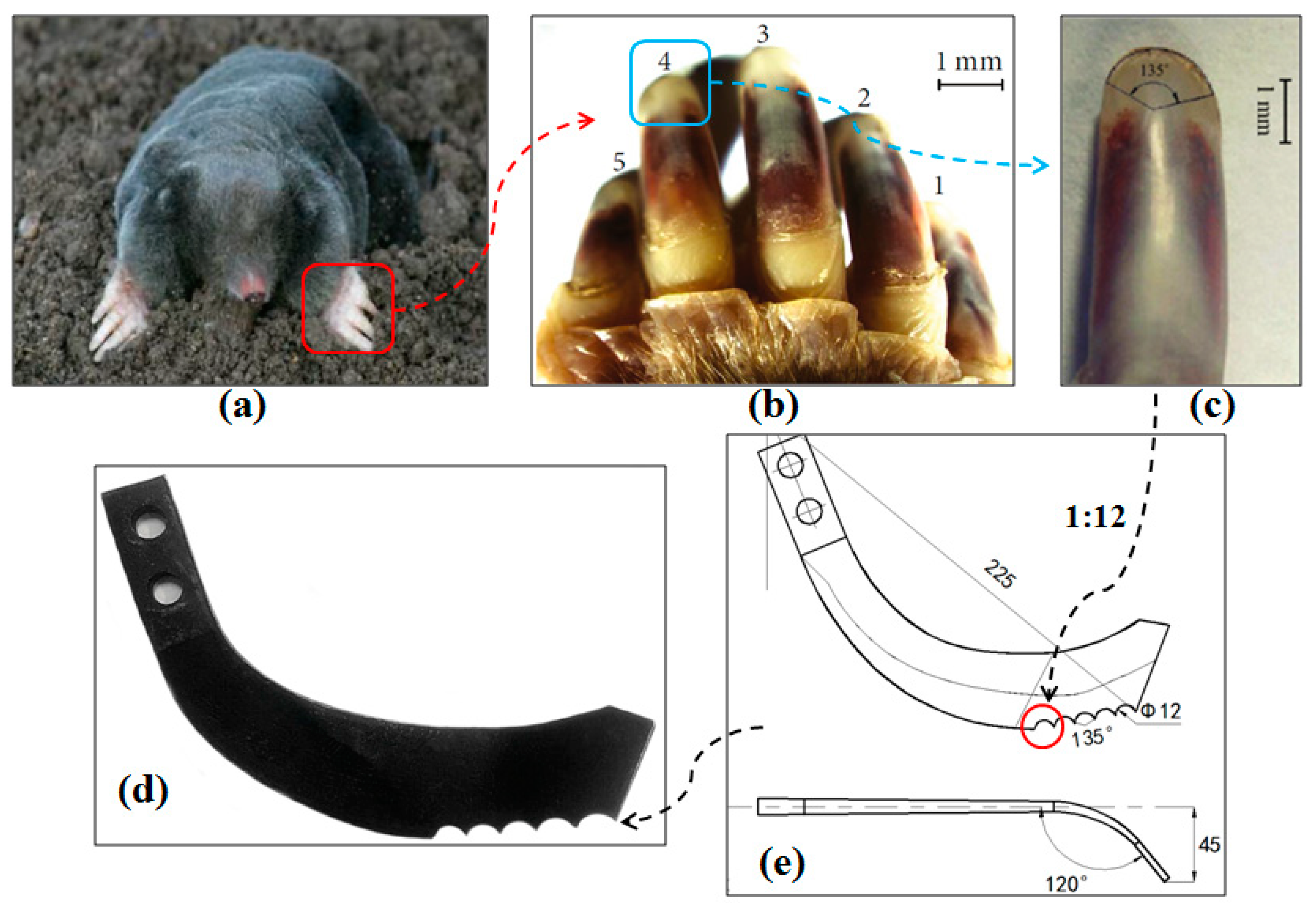
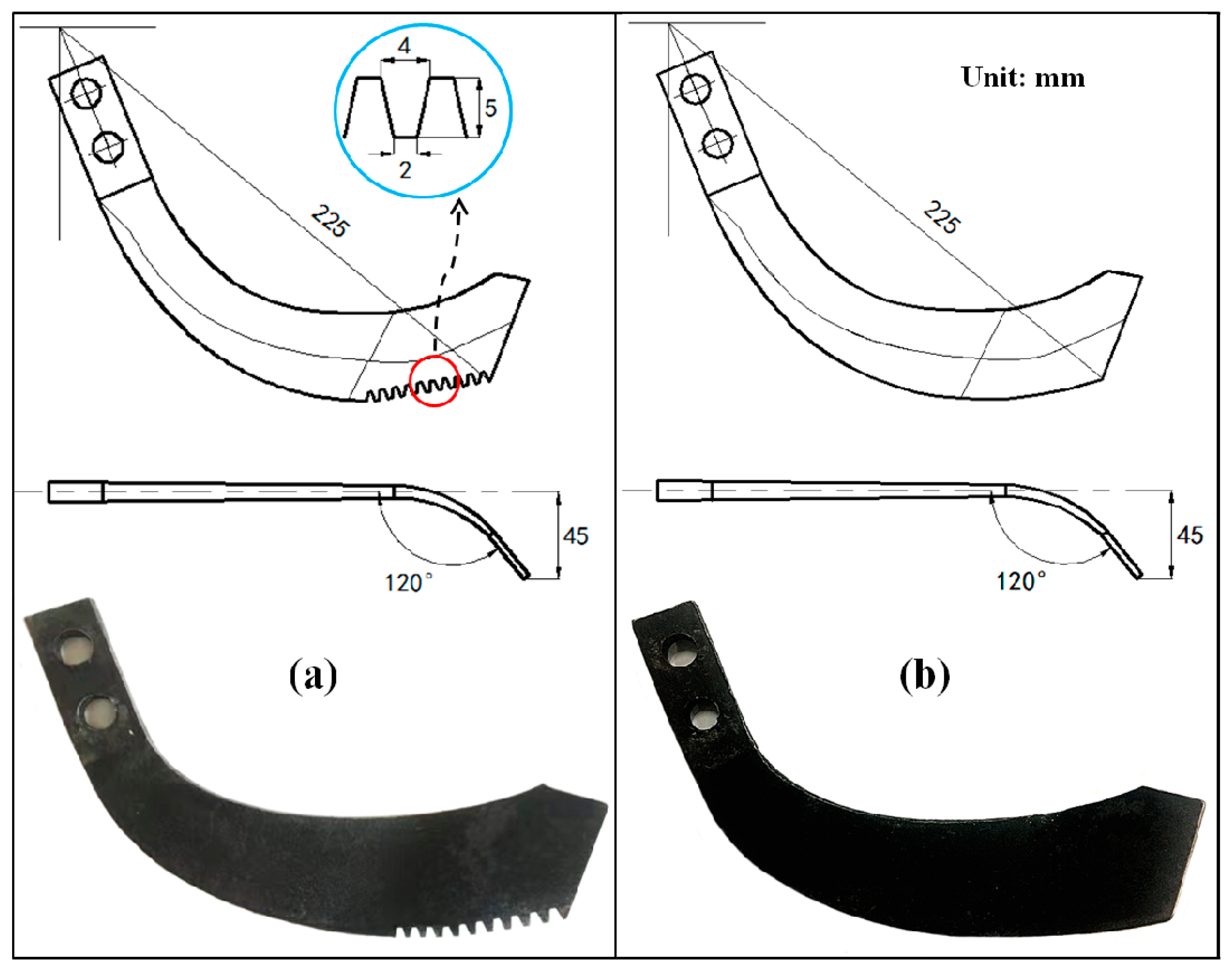

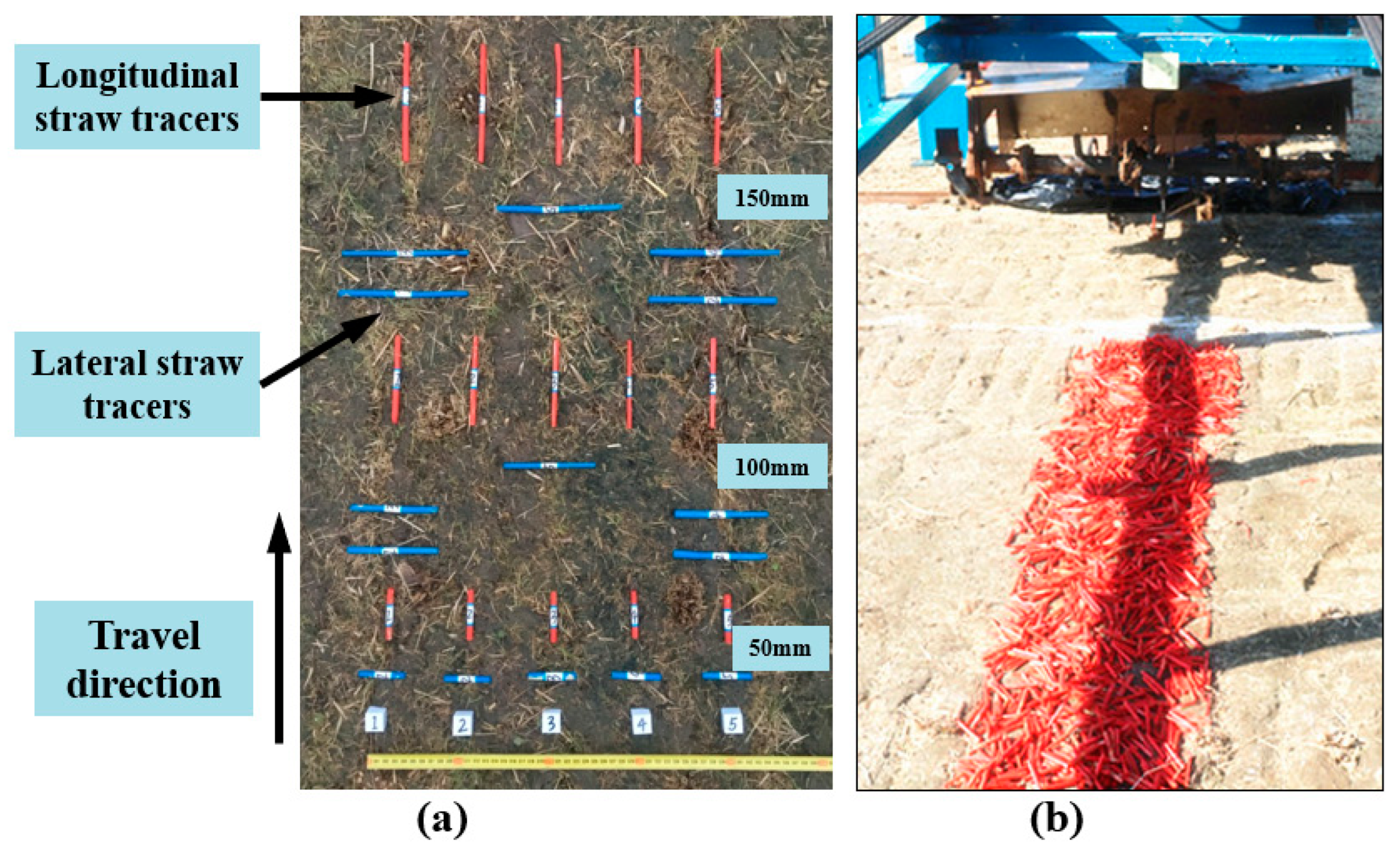

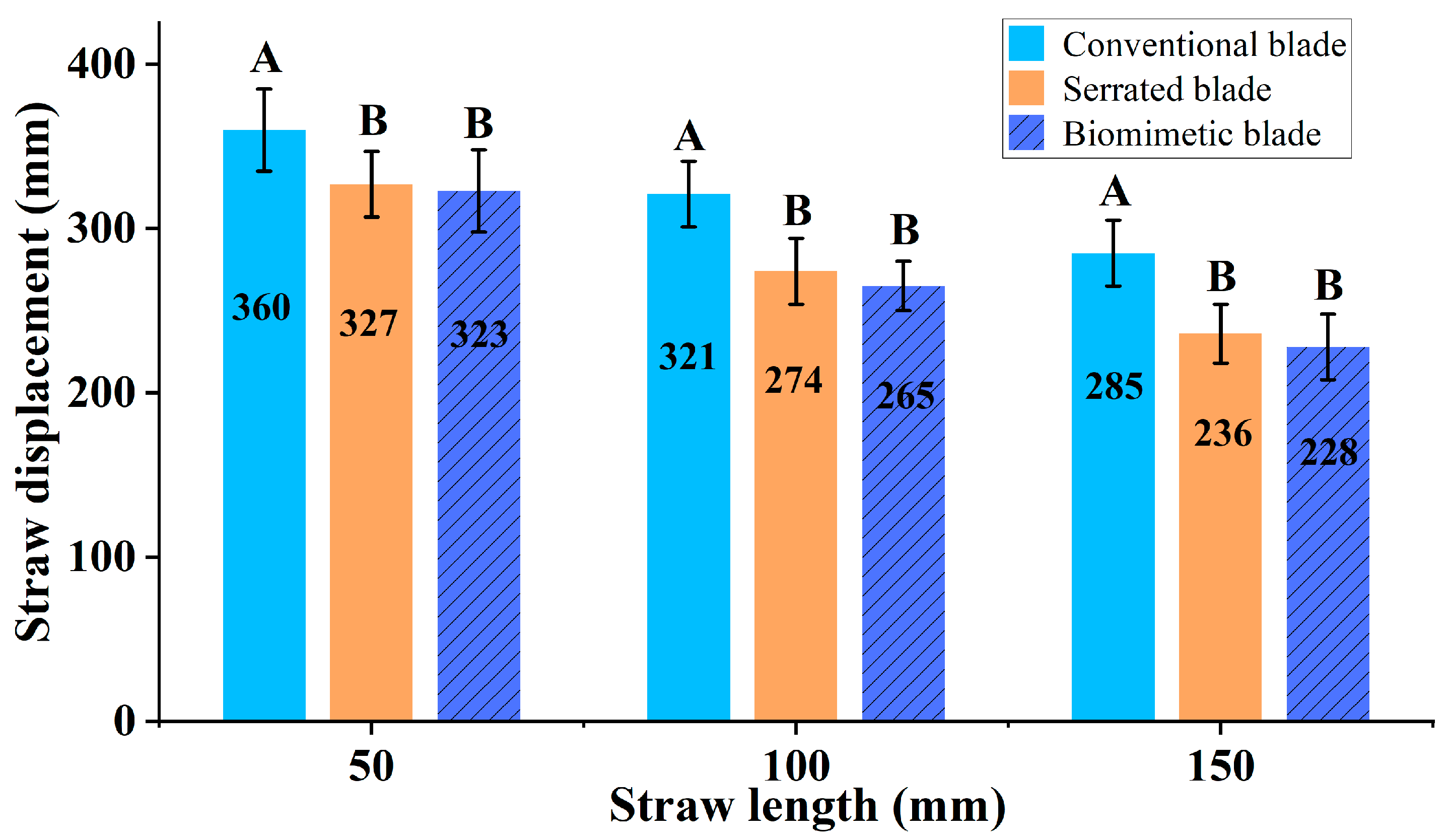
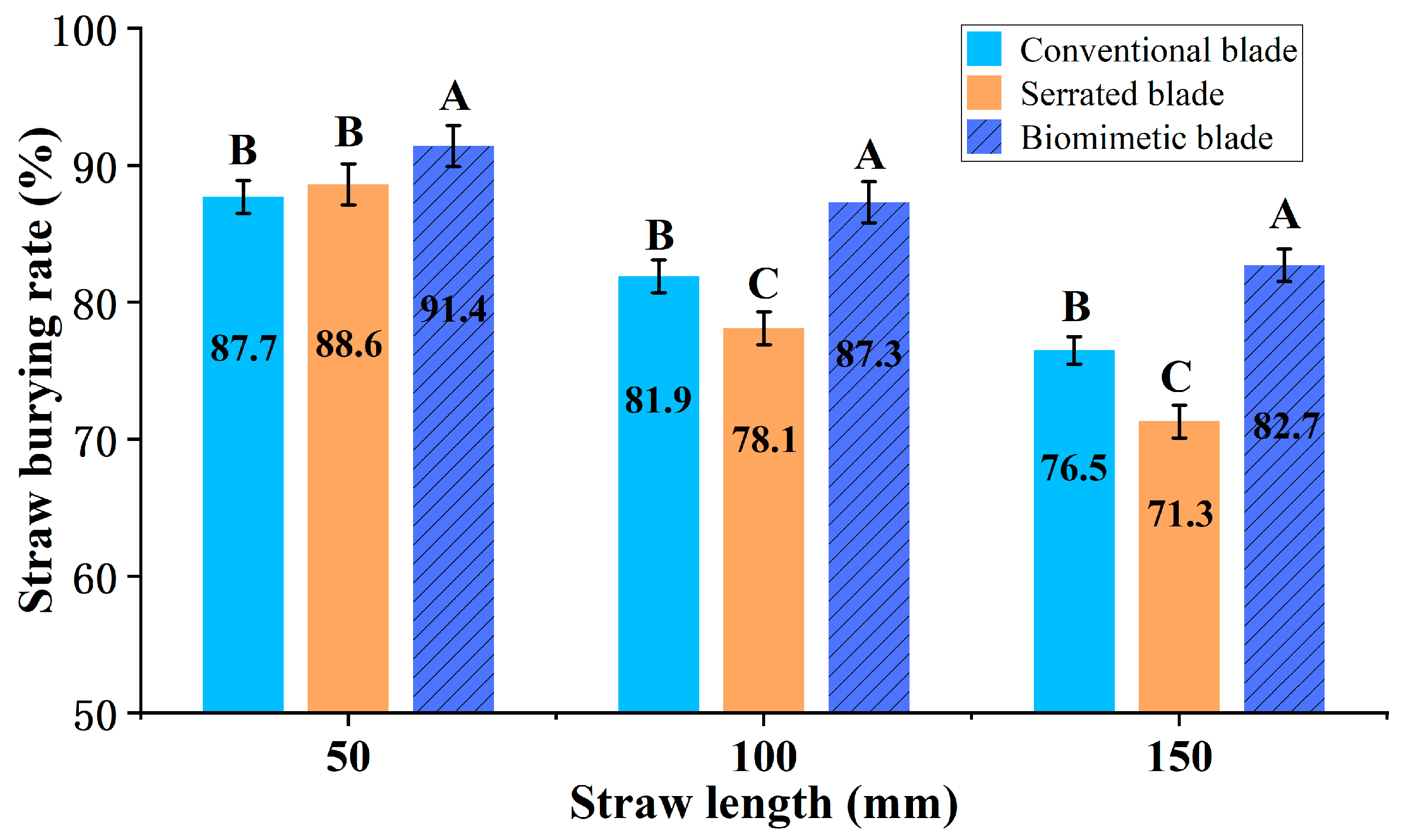

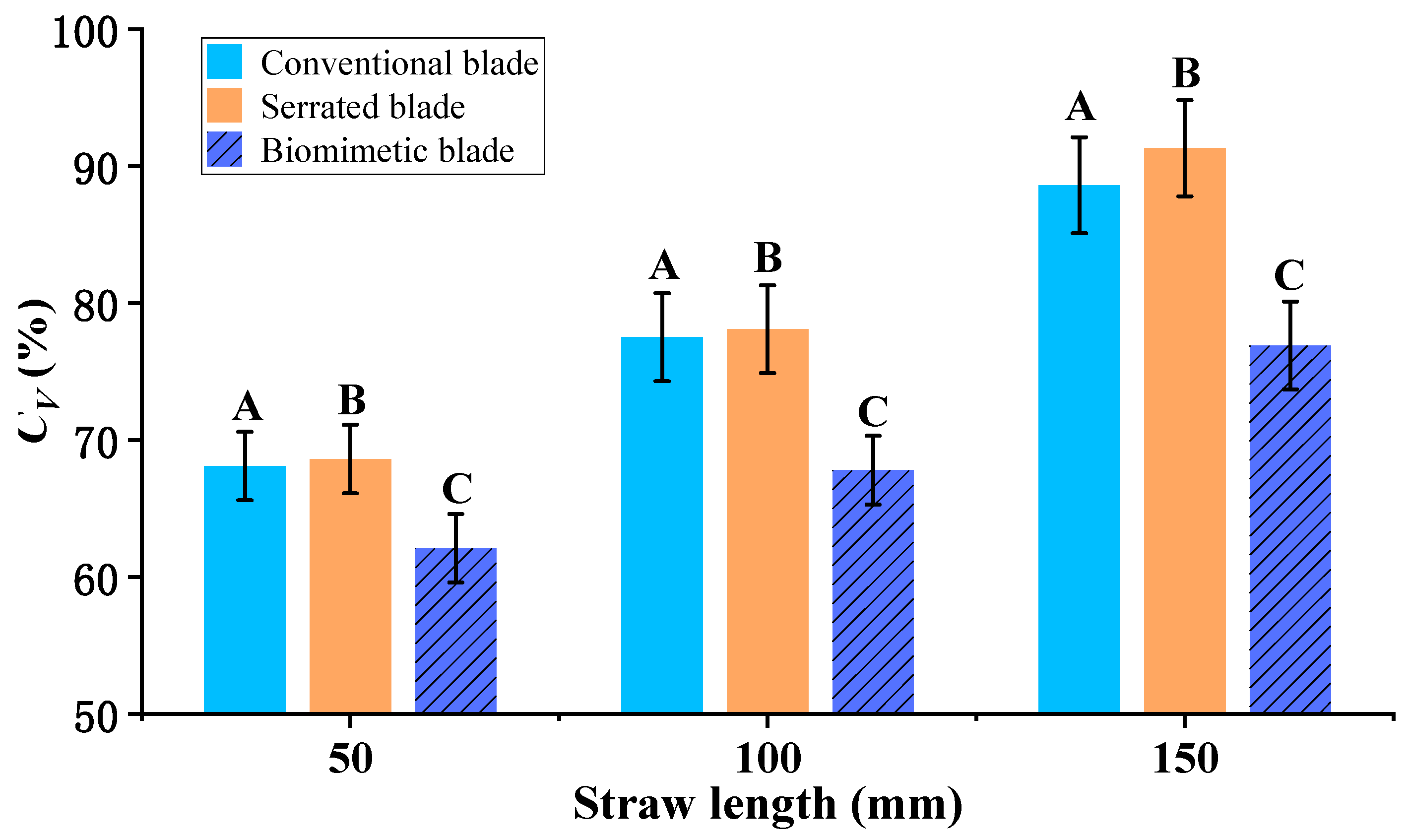
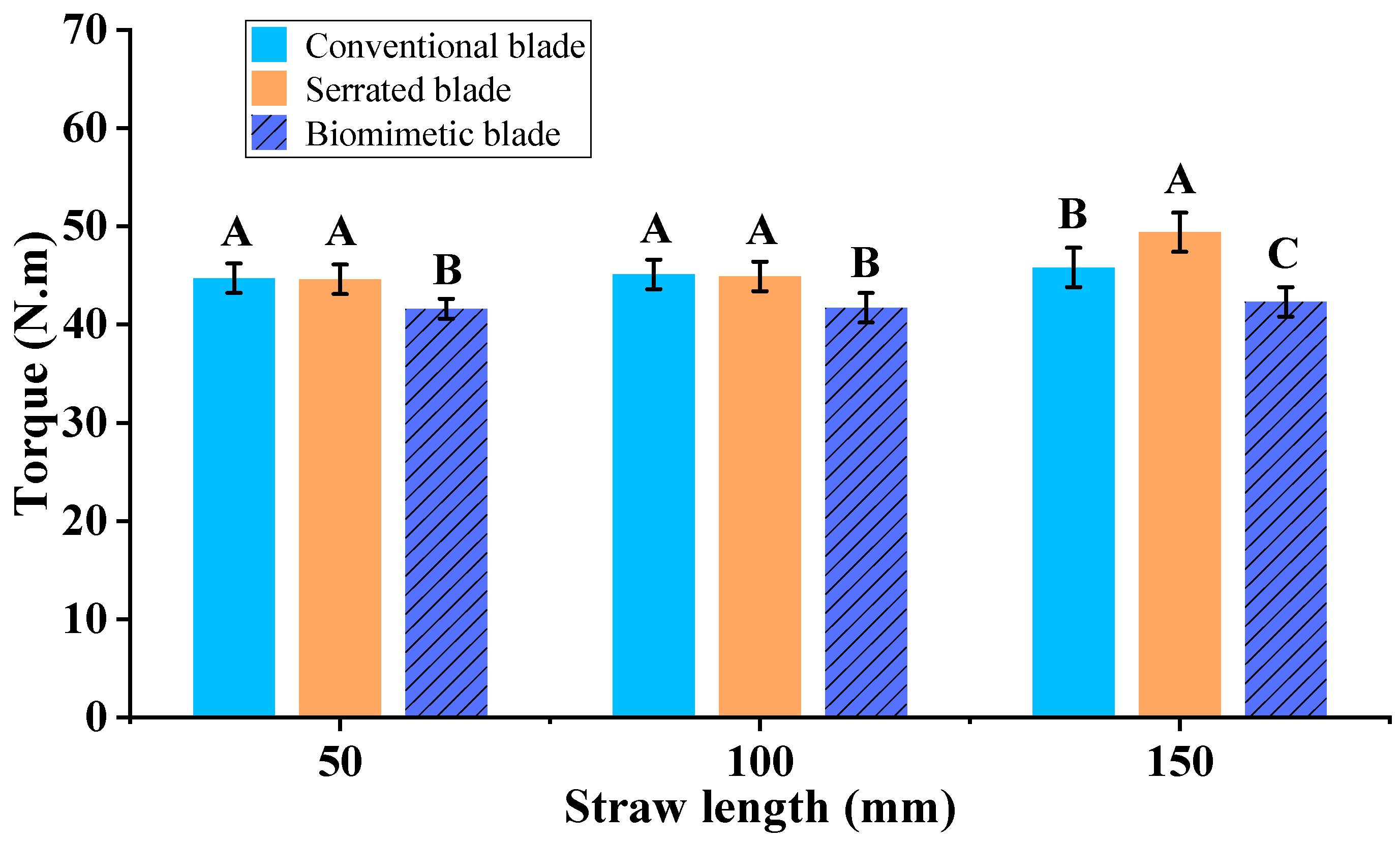
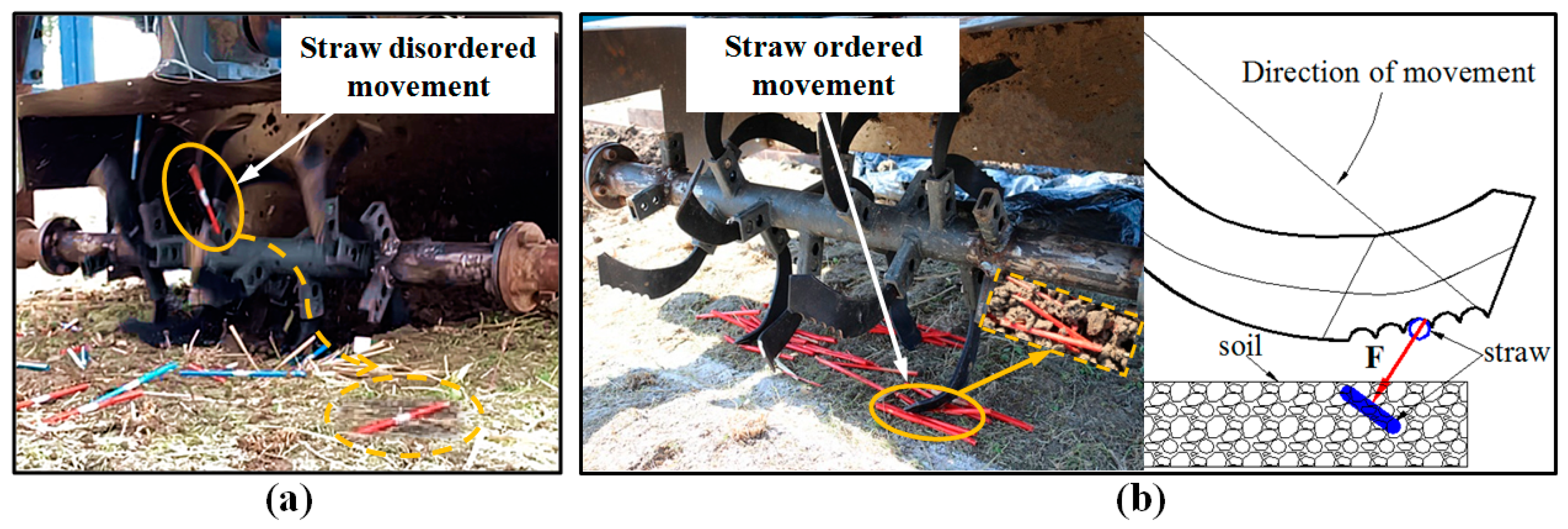
| Type | Parameters | Value |
|---|---|---|
| Soil | Cone index | 673, 984, 961 kPa at 50, 100, and 150 mm depths, respectively |
| Moisture content | 23.4, 23.9, 24.5% at depth of 0–50, 50–100, and 100–150 mm, respectively | |
| Dry bulk density | 1.29 g cm−3 | |
| Straw | Straw length | 0–150 mm |
| Wet density | 8051 kg ha−1 | |
| Dry density | 3972 kg ha−1 | |
| Moisture content | 50.6% (wet basis) |
| Specification | Blade Design | ||
|---|---|---|---|
| Conventional Blade | Serrated Blade | Biomimetic Blade | |
| Rotary radius, mm | 225 | 225 | 225 |
| Cutting width, mm | 45 | 45 | 45 |
| Bend angle, ° | 120 | 120 | 120 |
| Blade thickness, mm | 25 | 25 | 25 |
| Number of teeth | — | 10 | 5 |
| Tooth base width, mm | — | 4 | 11 |
| Tooth height, mm | — | 5 | 4 |
| Straw Length, mm | Layer, mm | The Total Length of Straw, mm | The Proportion of Straw, % | ||||
|---|---|---|---|---|---|---|---|
| Conventional Blade | Serrated Blade | Biomimetic Blade | Conventional Blade | Serrated Blade | Biomimetic Blade | ||
| 50 | UL (0–50) | 1274 ± 89 | 1231 ± 76 | 1081 ± 67 | 28.4 | 27.6 | 23.7 |
| ML (50–100) | 1761 ± 121 | 1792 ± 134 | 1865 ± 129 | 39.2 | 40.1 | 40.9 | |
| LL (100–150) | 1458 ± 105 | 1445 ± 97 | 1617 ± 102 | 32.4 | 32.3 | 35.4 | |
| 100 | UL (0–50) | 1676 ± 114 | 1850 ± 146 | 1504 ± 98 | 38.7 | 42.4 | 34.5 |
| ML (50–100) | 1642 ± 93 | 1734 ± 105 | 1583 ± 81 | 37.9 | 39.7 | 36.2 | |
| LL (100–150) | 1017 ± 77 | 783 ± 56 | 1281 ± 72 | 23.4 | 17.9 | 29.3 | |
| 150 | UL (0–50) | 2067 ± 148 | 2219 ± 154 | 1792 ± 133 | 47.3 | 50.8 | 41.1 |
| ML (50–100) | 1743 ± 126 | 1761 ± 118 | 1674 ± 105 | 40.0 | 40.3 | 38.4 | |
| LL (100–150) | 556 ± 42 | 389 ± 41 | 895 ± 64 | 12.7 | 8.9 | 20.5 | |
| Straw Length, mm | Average Power, W | ||
|---|---|---|---|
| Conventional Blade | Serrated Blade | Biomimetic Blade | |
| 50 | 1310.6 ± 37.5 a | 1307.6 ± 39.3 a | 1219.7 ± 30.9 b |
| 100 | 1322.3 ± 38.2 a | 1316.4 ± 44.6 a | 1222.6 ± 31.8 b |
| 150 | 1342.8 ± 40.1 b | 1448.4 ± 47.4 a | 1240.2 ± 34.7 c |
Disclaimer/Publisher’s Note: The statements, opinions and data contained in all publications are solely those of the individual author(s) and contributor(s) and not of MDPI and/or the editor(s). MDPI and/or the editor(s) disclaim responsibility for any injury to people or property resulting from any ideas, methods, instructions or products referred to in the content. |
© 2024 by the authors. Licensee MDPI, Basel, Switzerland. This article is an open access article distributed under the terms and conditions of the Creative Commons Attribution (CC BY) license (https://creativecommons.org/licenses/by/4.0/).
Share and Cite
Chen, X.; Xu, G.; Zhang, X.; Tan, W.; Ding, Q.; Tagar, A.A. Performance Evaluation of Biomimetic-Designed Rotary Blades for Straw Incorporation in an Intensive Tillage System. Agriculture 2024, 14, 1426. https://doi.org/10.3390/agriculture14081426
Chen X, Xu G, Zhang X, Tan W, Ding Q, Tagar AA. Performance Evaluation of Biomimetic-Designed Rotary Blades for Straw Incorporation in an Intensive Tillage System. Agriculture. 2024; 14(8):1426. https://doi.org/10.3390/agriculture14081426
Chicago/Turabian StyleChen, Xinxin, Gaoming Xu, Xiaoyu Zhang, Weichao Tan, Qishuo Ding, and Ahmad Ali Tagar. 2024. "Performance Evaluation of Biomimetic-Designed Rotary Blades for Straw Incorporation in an Intensive Tillage System" Agriculture 14, no. 8: 1426. https://doi.org/10.3390/agriculture14081426





